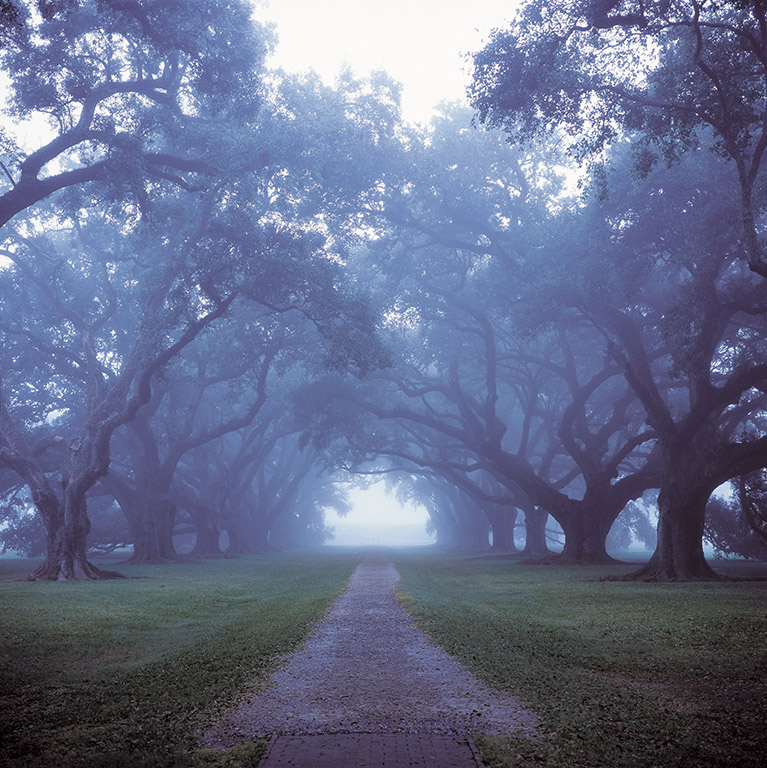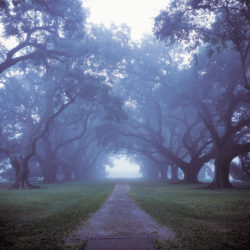Richard Sexton
Richard Sexton, a nationally recognized photographer, writer, book publisher, and teacher, lives and works in New Orleans.

Courtesy of Richard Sexton
Early Morning Fog, Oak Alley Plantation. Sexton, Richard (Photographer)
Richard Sexton, nationally recognized as a photographer, writer, book publisher, and teacher, lives and works in New Orleans, maintaining a studio in the city’s historic Faubourg Marigny, near the French Quarter. He is known for his extended photographic series and projects, often associated with the photographic publications that combine his focus on architecture, design, history, landscape, and preservation along with his interests in environmental issues and vernacular culture. Sexton is active internationally as an architectural photographer, with recent projects in Cuba, and has published photographs in many magazines, including Photo Metro, Abitare, Smithsonian, Louisiana Cultural Vistas, Harpers, and View Camera.
Sexton moved to New Orleans in 1991, established a studio in the city, and began to photograph the architecture and environment of New Orleans and the Gulf Coast South, working on the specialized photographic and literary publishing projects he initiated in San Francisco during the preceding decade with Chronicle Books. His first Louisiana project was New Orleans: Elegance and Decadence, written by Randolph Delehanty (1993). He published Vestiges of Grandeur: The Plantations of Louisiana’s River Road, in 1999. Soon after, with writers Lake Douglas and Jeanette Hardy, he completed Gardens of New Orleans: Exquisite Excess (2000). In 2008, with John Lawrence and Eugene Cizek, he collaborated on a book devoted to Destrehan Plantation, Destrehan: The Man, The House, The Legacy. During these years, he also launched two major, long-term photographic projects, both documenting the larger Gulf Coast South region, one titled The Highway of Temptation & Redemption: A Gothic Travelogue in Two (2) Dimensions (2005), and the other, Terra Incognita: Photographs of America’s Third Coast (2007).
When Sexton moved to New Orleans in 1991, it was actually a return to his native Deep South and the Gulf Coast area. He was born in Atlanta in 1954; his family lived and worked in Colquitt, Georgia, in the farming country west of Thomasville, near the Alabama and Florida borders, and not far from the Okefenokee Swamp. After completing his undergraduate degree at Emory University in Atlanta, Sexton moved to California in 1977, aspiring to obtain a master of fine arts degree in photography at the San Francisco Art Institute. Instead of continuing his MFA studies, in 1979 Sexton dropped out of art school classes, turned to commercial photography, and began to develop his professional skills as a darkroom technician.
In California, the first book Sexton wrote and photographed, American Style, Classic Product Design from Airstream to Zippo (1987), served as the beginning of his collaborations with San Francisco’s Chronicle Books. Next he published The Cottage Book (1989), documenting the traditional cottage designs and architecture of the San Francisco Bay area. This was followed by In the Victorian Style (1991), written by San Francisco architectural historian Randolph Delehanty.
During the early 1990s, Sexton planned and initiated two major, independent, long-term photographic and research projects, evolving during the following two decades, each presented in significant exhibition and publication projects, The Highway of Temptation & Redemption: A Gothic Travelogue in Two (2) Dimensions, and Terra Incognita: Photographs of America’s Third Coast, published by Chronicle Books (2007; second edition 2010). Reflecting his interests in sustainable planning and design, he published books on the evolving history of “new urbansim” communities that emerged in the late twentieth century, including Parallel Utopias: The Quest for Community (1995), comparing Sea Ranch, California, and Seaside, Florida; and Rosemary Beach (2007), a Gulf Coast community in Florida.
In 2008, Sexton worked on a new project in New Orleans, creating a photographic series documenting the impact of Hurricane Katrina on the city’s modern architectural heritage. Created in collaboration with architect Arthur Q. Davis of Arthur Q. Davis FAIA and Partners, and the firm of Curtis and Davis (Nathaniel Curtis), It Happened by Design, The Life and Work of Arthur Q. Davis was published in 2009.
Sexton’s photographs are including in the collections of the New Orleans Museum of Art, the Ogden Museum of Southern Art in New Orleans, and the Historic New Orleans Collection, among others.
